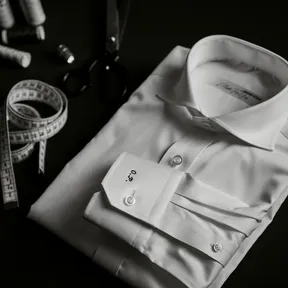To get an idea of what a fabric feels like looks like, and acts like without actually touching it we have added extensive information about all the fabrics on our webpage. Here, you'll find every bit of information you need to choose the right fabric for your shirt.
Below we will explain the different terms used in our information.
Composition
A fabric can be made of many different materials and for shirts cotton is the most common. However, cotton comes in a variety of qualities depending on the plant, where it is grown, etc. The main quality of cotton is measured in fibre, or staple length. The longer the staple, the better, smoother and more comfortable the fabric becomes. Below are some examples of materials that we use for shirts:
| Name |
Staple length |
Description |
| 100% Cotton |
15-40 mm |
Fabrics marked as 100% Cotton may contain fibres from different breeds of the cotton plant. Therefore, the staple length shown here is approximate. |
| 100% Long staple cotton |
> 30 mm |
Our long staple cotton fabrics are of high quality fibres that can originate from different growers all over the world. |
| 100% Egyptian cotton |
> 40 mm |
Egyptian cotton is probably one of the most well-known cottons in the world. Known for its long staples and superior quality the egyptian cotton is a premier choice for your shirts. |
| 100% Linen |
< 1400 mm |
Linen has extremely long fibre lengths and is a very strong material, especially when wet. |
Yarn
When choosing a fabric, the yarn decides a lot of the feel and comfort of the garment. Yarns come in either one-ply or two-ply constructions which means that it is made from either a single yarn or two yarns twisted around each other. Two-ply yarns gives a garment higher comfort and a silkier feel. Often fabric manufacturers choose to use a two-ply yarn in the warp (yarn running along the length of the fabric) and one-ply for the weft (yarn running across the fabric).
The thickness of the yarns used in our fabrics are defined using the Ne system, which basically is the number of 840 yard lengths in one english pound. So, a higher number is a finer yarn. However, a Two-ply 100s yarn is the same thickness as a one-ply 50s.
Some examples:
| Yarn |
Description |
| Warp 80/2, Weft 80/2 |
Means that both warp and weft contains two-ply threads that are 80 Ne thick (equal thickness to a one-ply 40s). |
| Warp 100/2, Weft 50/1 |
Means that the warp has a two-fold 100 Ne yarn and the weft has a one-ply 50 Ne yarn, both are the same thickness. |
Colour information
To present correct colours on a computer screen is very difficult and most screens differ substantially from each other. For example, a colour that appears brown on one screen might appear olive green on another. When producing pictures of our fabrics, we use special colour-calibrated equipment to make the colours look as life-like as possible. However, to avoid matching errors we always provide information on what colours a fabric contains. These colours are visible in small boxes with a text describing the colour. If you are still uncertain of a colour we suggest you order a sample to make sure you get a fabric that suits you.
Weaving information
Fabrics are woven with many different weaving techniques. We have distinguished some of the more important ones and categorized our fabrics accordingly.
| Weave |
Description |
| Plain weave |
Plain weaves are the most simple of all the weaves. Same size warp and weft threads are woven together one by one. |
| Poplin |
Poplin is a tightly woven fabric that, like the plain weaves, is constructed with equal size warp and weft threads. The difference from a plain weave is that the poplin warp yarns are much more tightly packed, often double that of the weft yarns. |
| Oxford |
Oxford is often a heavier cloth than poplin, a soft durable fabric woven in a basket weave with two warp yarns in parallel and one heavier softly-spun bulky filling yarn. When made with a dyed warp and white weft, it is called oxford chambray. |
| Pinpoint oxford |
Pinpoint, or Pinpoint Oxford, is a variation of the oxford cloth. The yarns are finer making it a subtle mix of poplin and oxford. |
| Fil-à-fil |
Fil-à-fil fabric is woven with threads in two different colours giving it an irregular effect. It is a thin and comfortable material suitable for solid colour shirts. |
| Twill |
Twill is a weaving method that creates a diagonal pattern in the fabric. These fabrics are generally softer and thus more wrinkle resistant, however not wrinkle free, than plain weaves. |
| Herringbone |
Herringbone is a variation of the Twill weave, the only difference being that the pattern produced resembles the bones of a fish. |
| Dobby |
A dobby weave is usually an advanced construction to produce a texture in the fabric. Often dobby weaves contain multiple yarn sizes and weaving techniques, for example small twill stripes on a plain weave or a zig-zag pattern. |
| Flannel |
Flannel is woven with either a plain or twill weave. It is made from loosely spun yarns, giving it a soft feel and insulating properties. |
| Seersucker |
Seersucker is a thin cotton fabric, commonly striped or checkered, where the yarns are woven in a special way to give the fabric the typical uneven or bumpy texture. The word originates form India and the persian words "shir" and "shakar" meaning "milk and sugar", propably for its resamblance of the smooth eveness of milk and the rough texture of sugar. The fabric is often used in summer wear and sports- and casual wear. |
| Satin |
Satin is somewhat more shiny that the average twill fabric. Its luster provides a more exclusive impression. |
Treatments
Our fabrics are sanforized to minimize shrinkage after wash. Many fabrics come with a chemical treatment, such as softener and easy care for easier ironing which is indicated next to each fabric.
Weight
The weight of the fabric is a way of measuring both the thickness of the fabric and how densely it is woven. Many of our fabrics have exact weight information available, from about 50 to 200 g/m2, but some only have a grading of 1-5.
 About our dress shirts
About our dress shirts About our suits
About our suits




